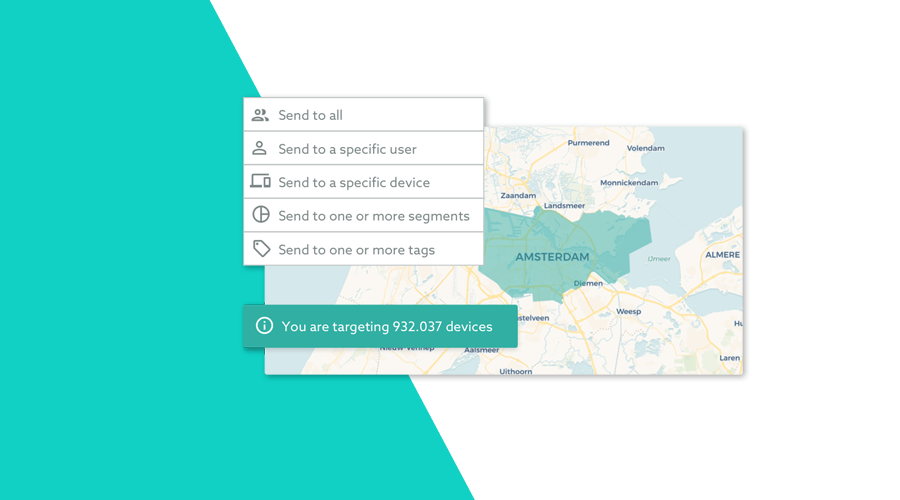We are proud to announce that this week's release introduces brand new functionality that takes our advanced criteria to a whole new level. This important piece of functionality has seen incredible adoption and almost 60% of our clients now use advanced criteria in all their messaging and contextual content campaigns. It is also a long-awaited feature that we have been cooking for some time, but it required some crucial under-the-hood development before it could be introduced.
What is Advanced Criteria?
For those of you that are not familiar with this functionality, it is how you can can have fine-grained selections of devices when composing a message, creating contextual content assets or generating export jobs. It allows you to combine Segments, Tags, Locations and Device Properties in a very powerful query language that our platform uses to deliver the right content to the right crowd.
What's new?
Starting today, you can also use User Data Fields to create even more powerful campaigns. As mentioned in a previous post, this is how many of you are creating incredibly rich user profiles.
For this reason, this new feature becomes essential in order to harness all the potential stored in those bits of information. This will also progressively replace how you categorize users now. What was usually accomplished using user-level (Segments) or device-level (Tags) categorization can now be done using the data you have been storing in user profiles.
Additionally, we have also introduce a new operator. In addition to all the comparison operators available for you in advanced criteria, we are also introducing a new one today - Starts With. With this new operator, you will be able to filter results by partially matching a string with the values stored in both Device Properties and User Data Fields.
How to use it?
If you are not familiar with User Data Fields, these can be added in each application you create in Notificare, in Settings > Configure App. They can now have 4 different types, Text, Number, Date or Boolean. You can use them to store even more types of data in your users profiles.
By default, all fields created before this update were assigned as Text. This type will probably be more than enough for most use cases but if you do plan to change it, please bear in mind that changes in a production application will effectively skew the data stored in those profiles, as the new data will be stored with a different type than existing data. To avoid potential problems, you will either need to update any values for the fields you change, for all your users, or simply create a new field and introduce it with a new version of your mobile app or website.
As soon as your application contains at least one User Data Field, all the areas of our dashboard where advanced criteria is available, will have a new option:
Selecting this new option will add an entry in your advanced criteria that allows you to select one of or more User Data Fields:
You can use it to create powerful device selections:
You can even combine it with existing Segments, Tags, Locations or Device Properties.
What can you do with it?
As you can see, this new functionality will enable you to reach users in powerful new ways. Because User Data Fields can be stored directly from your mobile app, website or even using our REST API, they can be used to store user personal information, preferences or application related information. This is why you should carefully plan what types you pick for the data you want to store.
Text
This is probably the most common type of data you will store. For most cases, storing data as text will be enough to perform powerful queries. Of course, unless the data you store does have a certain format, using operators like Greater Than or Less Than will not be feasible.
Number
This is the perfect type to store values that you plan to perform comparisons like we've mentioned above. Think of things like the loyalty points or store credit of a user or the game level reached.
Date
Storing dates can be very powerful. You can use it to store the birth dates of users or when users provided consent for notifications or location services. You should however take into consideration that these values must be saved in ISO 8601 format and UTC (i.e. 2021-04-16T00:00:00Z). For example, in most cases, it becomes much simpler to save dates as a text (i.e. 1979-02-24) and still harness the powerful comparison operators without having to worry about time or timezones.
Boolean
Finally, this type of data is ideal for those bits of information that must hold 2 possible values, true or false. Perfect for keeping track if users agreed with your terms of service or gave consent to a certain piece of functionality in your mobile app or website.
Interested?
This piece of functionality has the potential to revolutionize how brands reach their audience. We cannot wait to see all the powerful queries you will use in your next messaging or contextual content campaigns, how you will filter the audience you reach in geo-triggers and automation connectors or how you will create fine-grained export files ready to be used by data analytics or 3rd party software in your marketing stack.
As always, we are available for any question you might have via our Support Channel. Additionally, if you want to see this in action, don't hesitate and book a demo today.


